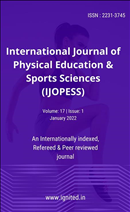A Statistical Technique to Develop a Discriminant Model to Categories Senior Female Cricketers of Gujarat into Batsman and Bowler
Main Article Content
Authors
Abstract
Aim of the study The aim of the study was to develop a criterion for classifying female cricket playersinto batsmen and bowlers by using discriminant analysis function on the basis of physiological andanthropometric variables.Material and Methods A sample of thirty [N = 30] female cricket players who was the part of interuniversity team of Swarnim Gujarat Sports University in the year 2021-22. So that the players wereclassified into batsmen and bowlers on the basis of predictor variables.Results A significant difference between batsmen and bowlers was found in physiological andanthropometric variables i.e. FVC, VO2 MAX, Total arm length, Shoulder diameter. Furthermore, Themean value is higher in bowlers in case of (vo2 max, shoulder diameter), While the mean value is more inbatsmen in terms of Total arm length, FVC6. The attained discriminant model classified correctly 80.0 ofthe cases in the sample.Conclusion- This study clearly remarks the difference present in the physiological and anthropometricvariables of women’s batsmen and bowlers. The result of the study is that the coaches can usephysiological and anthropometric variables for players i
Downloads
Download data is not yet available.
Article Details
Section
Articles
References
- Gosh, N. and Mondal, P. (2016). A study on the effect of limb length and arm strength on the ball release velocity in cricket. International Journal of Physical Education, Sports and Health. 3(6), 389-393
- Koley, S. (2011). A study of anthropometric profile of Indian interuniversity male cricketers. journal of human sport & exercise. 6(2), 427-435.
- Yadav, N. (2019). sports specific effect on vital capacity in sportsmen and non sportsmen. Indian journal of research.8(5), 2250 - 1991.
- Tyagi, A. (2017). Impact of Field Training on Selected Physiological Parameters among Cricket Players. Imperial Journal of Interdisciplinary Research (IJIR). 3(1).
- M. Leone, G. Lariviere, & A. S. Comtois. (2002). Discriminant analysis of anthropometric und biomotor variables among elite adolescent female athletes in four sports. Journal of Sports Sciences, 20(6), 443-449.
- McArdle, W.D., Katch, F., Pechar, G., Jacobson, L., and Ruck, S. (1972). Reliability and interrelationships between maximal oxygen intake, physical work capacity and step test scores in college women. Medicine and science in sports, 4(4), 182-186.
- Sathe, P. (2018). Anthropometric characteristics of young Indian cricket players and their relationship with playing experience. International journal of recent scientific research. 9(10), 29352-29354.
- Singh, T., Devi, W. (2017). A study of physiological variables among male cricketers of Chandigarh. International Journal of Physiology, Nutrition and Physical Education. 2(2), 914-917.
- Saha, K. (1989). Assessment of Some selected physiological variables as limiting factor in fast bowling in Cricket", Unpublished Master's thesis, Jiwaji University.
- Negi,B. (2015). A comparative study of physiological variables of female cricket players at different levels of participation. International Journal of Research Review in Engineering Science and Technology. 4(4), 61-74.
- Tripathi, S. and Arvind. (2017). An Analytical Study of Chest Girth, Vital Capacity and Respiratory Rate of Inter Collegiate Players of Selected Ball Games. Global Journal of Medical Research: K Interdisciplinary.17(1), 16-18.

